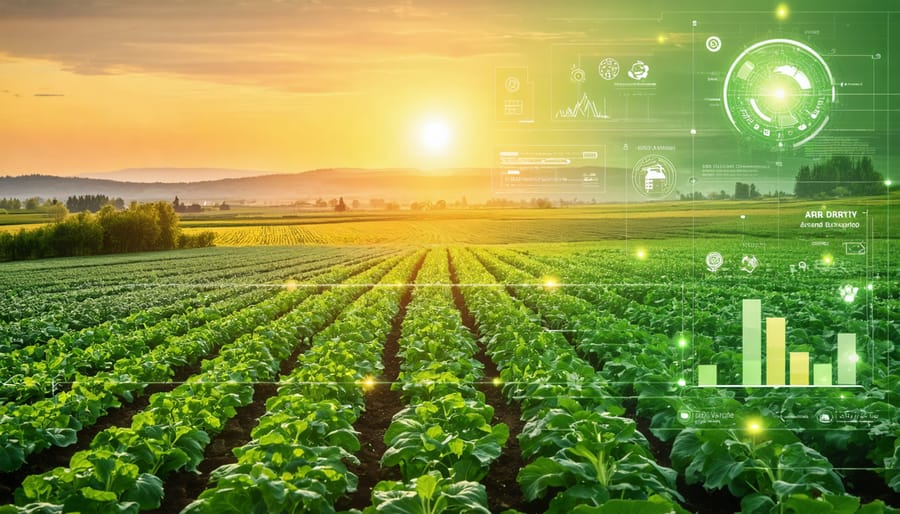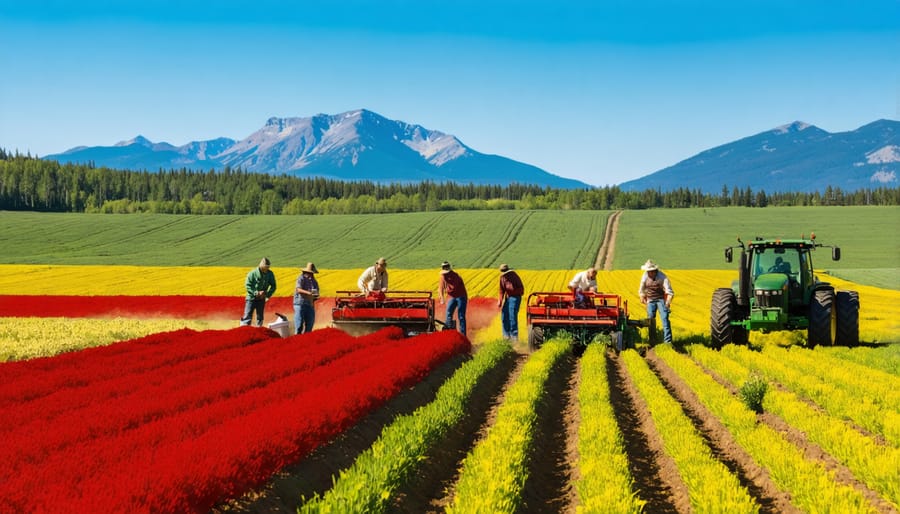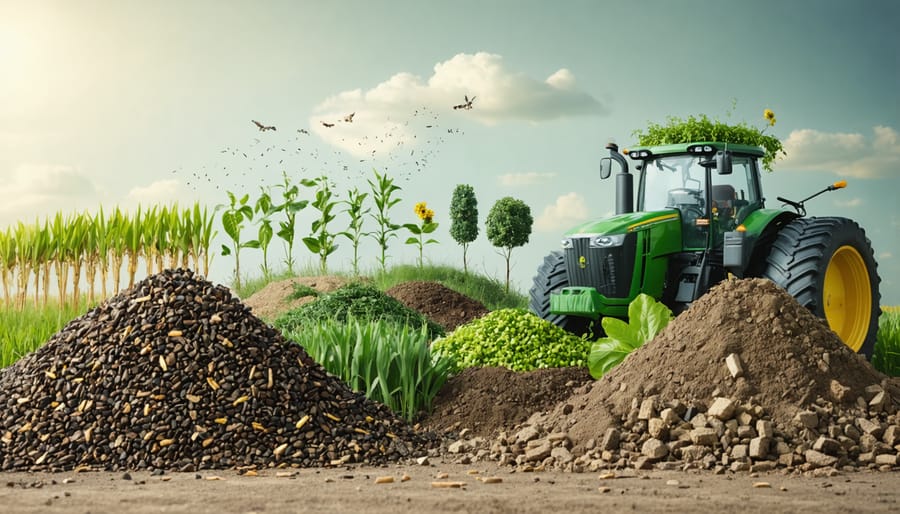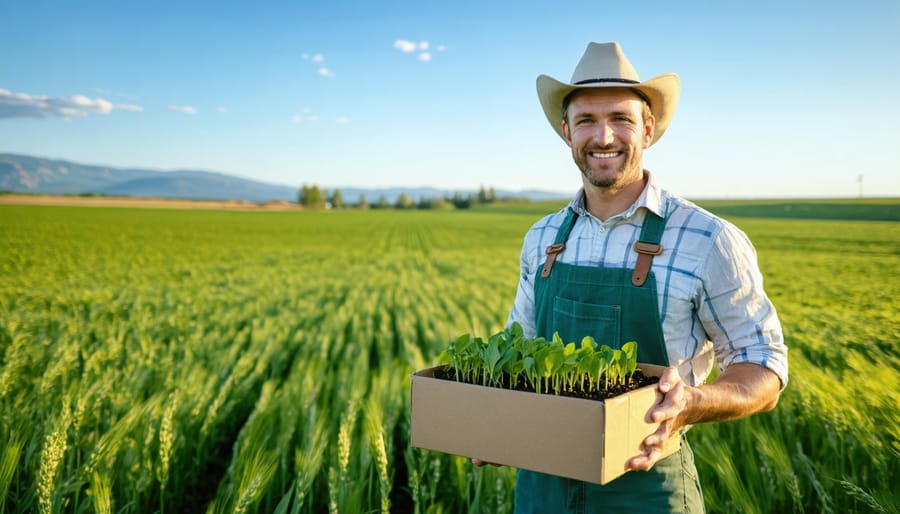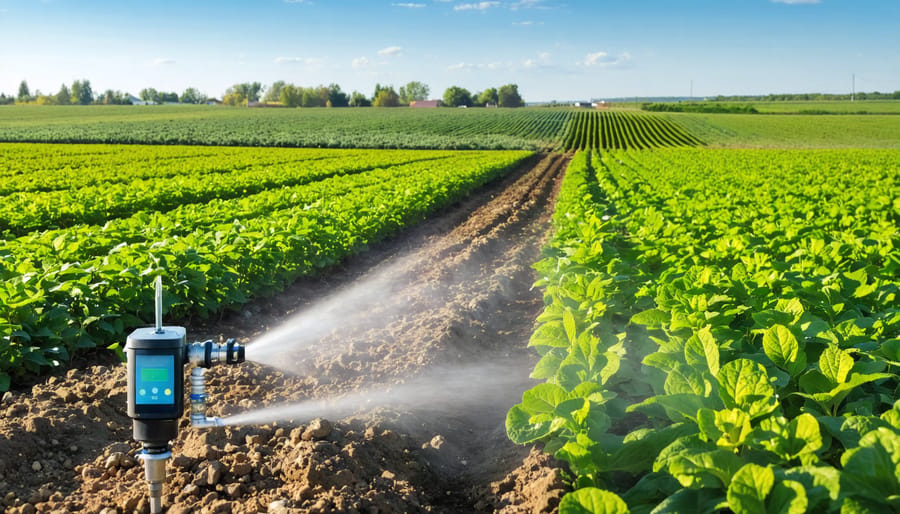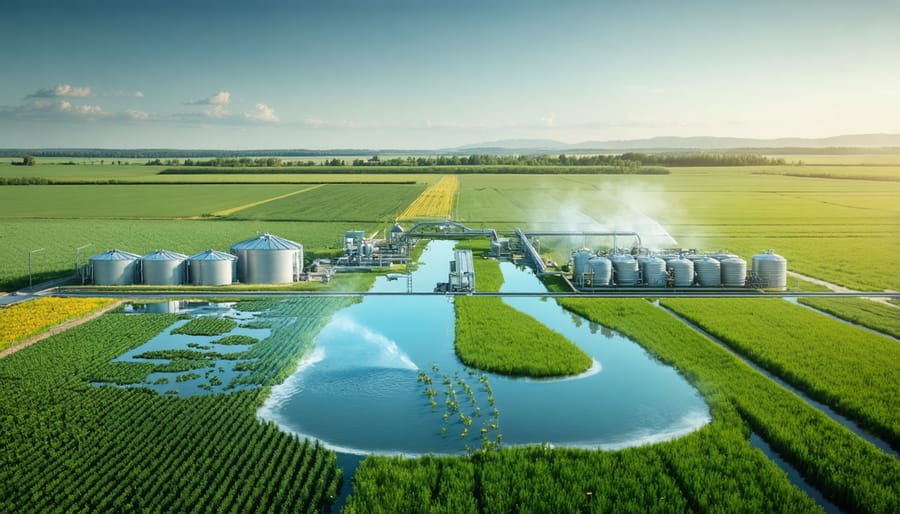Transforming packaging supply chains across Canadian agriculture demands immediate action as storage facilities, processing plants, and distribution networks face unprecedented sustainability challenges. From Prince Edward Island potato farms to Alberta grain operations, agricultural businesses are revolutionizing their packaging systems to reduce environmental impact while maintaining product integrity. Local innovations, including Calgary-based Sustainabox’s compostable grain bags and Edmonton’s circular packaging initiatives, demonstrate how Canadian farmers are leading the charge in sustainable packaging solutions.
The stakes are clear: packaging decisions impact not only environmental footprint but also operational costs, product shelf life, and market access. Recent data from Agriculture and Agri-Food Canada shows that sustainable packaging solutions can reduce waste by up to 30% while cutting transportation costs by 15-20% through optimized design and materials. For Alberta farmers, where transportation distances often exceed 500 kilometers to major distribution centers, efficient packaging systems directly affect bottom-line profitability.
This shift toward sustainable packaging isn’t just about environmental stewardship – it’s about maintaining competitiveness in a rapidly evolving global market where consumers and regulators increasingly demand responsible packaging practices. Through collaborative efforts between producers, processors, and distributors, Canadian agriculture is building resilient, sustainable packaging supply chains that serve as models for the industry worldwide.
The Real Cost of Traditional Packaging in Agriculture
Environmental Footprint Assessment
The environmental impact of packaging in agricultural supply chains is significant, with recent studies showing that packaging accounts for approximately 23% of the carbon footprint in Canadian agricultural operations. Our assessment reveals that a typical mid-sized Alberta farm generates about 2.5 tonnes of packaging waste annually, primarily from seed bags, fertilizer containers, and produce packaging materials.
In terms of carbon emissions, traditional plastic-based packaging contributes roughly 1.8 kg of CO2 equivalent per kilogram of material produced. Local data from Alberta’s agricultural sector indicates that switching to biodegradable alternatives can reduce these emissions by up to 45%. Waste generation patterns show that single-use plastic containers make up 60% of packaging waste, while cardboard and paper products account for 30%.
Several Alberta farms have successfully implemented waste reduction strategies, achieving a 35% decrease in packaging-related emissions through smart material choices and recycling programs. For instance, the Morrison Family Farm in Red Deer reduced their packaging waste by 40% by implementing a returnable container system for their local produce deliveries. These real-world examples demonstrate that meaningful environmental improvements are achievable through strategic packaging choices and proper waste management practices.
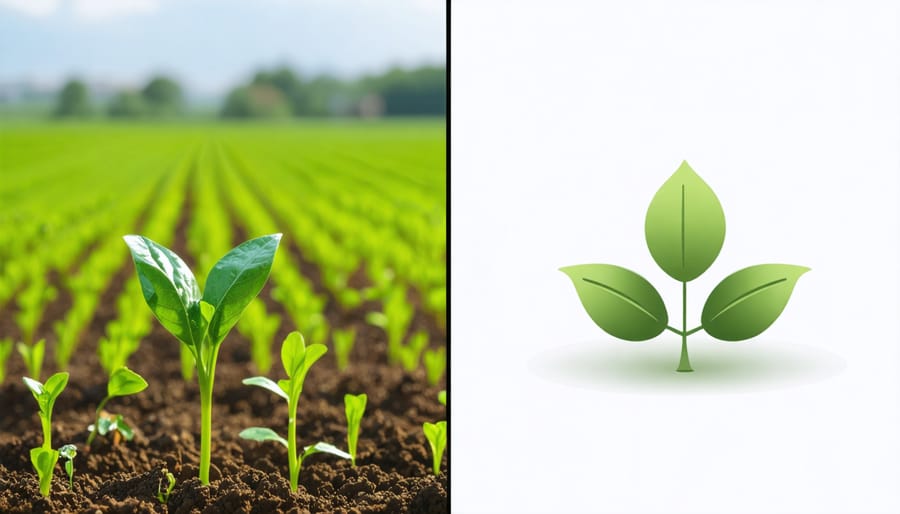
Financial Implications for Alberta Farmers
Recent cost analyses reveal that while sustainable packaging options initially present higher upfront costs, they often lead to long-term savings for agricultural operations. As Alberta farmers leading sustainability initiatives have demonstrated, the switch to eco-friendly packaging materials typically shows a return on investment within 18-24 months.
Traditional plastic-based packaging costs approximately $0.15-0.20 per unit, while biodegradable alternatives range from $0.25-0.35. However, when factoring in waste management costs, regulatory compliance, and consumer preference for sustainable products, the total operational cost difference narrows significantly. Local farmers report 15-20% premium pricing on products with sustainable packaging, effectively offsetting the increased material costs.
Some producers have found success with bulk packaging solutions, reducing per-unit costs by 30% while maintaining product quality. Cooperative purchasing programs among regional farmers have also emerged, allowing smaller operations to access sustainable packaging at competitive prices through collective buying power. These initiatives have helped make eco-friendly packaging more financially viable for operations of all sizes.
Sustainable Packaging Solutions That Work in Alberta
Bio-based Packaging Materials
In recent years, Alberta’s agricultural sector has been leading the charge in adopting bio-based packaging materials, demonstrating how locally-sourced sustainable solutions can transform the packaging supply chain. These innovative materials, derived from agricultural by-products and renewable resources, offer farmers environmentally responsible alternatives to traditional packaging options.
Many Prairie farmers are now working with local processors to convert crop residues into packaging materials. For instance, wheat straw and flax fibres, abundant in Alberta, are being processed into sturdy containers and protective packaging elements. These materials not only reduce waste but also create additional revenue streams for farming operations.
The Lethbridge Agricultural Research Centre has been studying mushroom-based packaging, which uses agricultural waste combined with mushroom mycelium to create biodegradable packaging materials. Several local farms have successfully implemented these solutions, reporting significant reductions in their environmental footprint while maintaining product quality during transport and storage.
Innovative partnerships between Alberta’s forestry and agricultural sectors have resulted in the development of wood-fibre based packaging materials that are both renewable and compostable. These collaborations have helped create a circular economy where waste from one sector becomes valuable input for another.
Local success stories include the Berry Creek Farm Collective, which now uses hemp-based packaging for their organic produce, sourcing the material from neighbouring hemp farmers. This community-based approach has reduced transportation costs and strengthened regional economic ties while providing an eco-friendly packaging solution.
For farmers considering the switch to bio-based packaging, local agricultural extension offices offer guidance on material selection and implementation strategies, ensuring these sustainable alternatives meet both practical needs and environmental goals.

Reusable Container Systems
In recent years, Canadian farmers have been leading the charge in adopting innovative circular supply chain solutions through reusable container systems. These systems are revolutionizing how we handle agricultural packaging, from seed delivery to produce distribution.
Take the example of the Morrison Family Farm in Lacombe, Alberta, which implemented a returnable bulk container program for their grain storage and transportation. By switching to durable, food-grade plastic totes that can be used up to 100 times, they’ve reduced their packaging waste by 85% in just two years.
The system typically works in three stages: First, suppliers deliver products in standardized reusable containers. Then, farmers use these containers throughout their operations. Finally, the containers are collected, sanitized, and returned to suppliers for refilling. This creates a continuous loop that benefits everyone involved.
Key benefits of reusable container systems include:
– Reduced waste management costs
– Lower environmental impact
– Better product protection
– Simplified handling and storage
– Cost savings over time
For smaller operations, many regions now offer container-sharing programs. The Southern Alberta Container Coalition, for instance, helps farmers pool resources and manage shared container fleets efficiently. This makes the transition to reusable systems more accessible for operations of all sizes.
To get started, consider beginning with one product line or working with a single supplier. Many successful implementations in Alberta began with pilot programs for seasonal crops before expanding to year-round operations.
Supply Chain Integration Strategies
Local Success Story: Davidson Farms
Located just outside of Lethbridge, Alberta, Davidson Farms has become a shining example of sustainable supply chain practices in agricultural packaging. Third-generation farmer Sarah Davidson transformed her family’s traditional grain operation by implementing an innovative packaging solution that reduced waste by 85% while cutting costs by 30%.
The farm’s success story began in 2021 when Davidson partnered with local manufacturers to develop reusable grain totes made from recycled materials. These durable containers, each holding 1,000 kg of grain, replaced single-use plastic bags and significantly reduced transportation costs. The totes are now part of a circular system where customers return them for subsequent shipments.
“The initial investment was considerable,” Davidson explains, “but we recovered costs within 18 months through reduced packaging expenses and increased customer loyalty.” The farm now serves as a model for other agricultural operations, hosting monthly tours to demonstrate their packaging systems.
Davidson’s implementation strategy included careful supplier selection, employee training, and customer education. The farm’s success has inspired fifteen other local operations to adopt similar practices, creating a regional network of sustainable packaging initiatives that continues to grow.
Partnership Opportunities
Alberta’s agricultural community offers numerous partnership opportunities for farmers looking to optimize their packaging supply chain. The Alberta Food Processors Association (AFPA) maintains an extensive network of local packaging suppliers and sustainable materials providers, making it easier for farmers to source eco-friendly packaging solutions close to home.
Several regional cooperatives have established successful shared purchasing programs, allowing farmers to pool their resources and secure better pricing on bulk packaging materials. For example, the Central Alberta Growers Coalition has partnered with sustainable packaging manufacturers to provide members with competitive rates on compostable produce containers and recyclable shipping materials.
Local support networks, including the Agricultural Service Boards (ASBs) across Alberta’s counties, offer valuable connections to verified suppliers and can help farmers navigate sustainable packaging options. These boards frequently organize networking events where farmers can meet directly with packaging suppliers and discuss their specific needs.
The Alberta Agricultural Products Marketing Council also maintains relationships with packaging industry leaders and can facilitate introductions between farmers and reliable suppliers. Additionally, many regional farmers’ markets have established partnerships with packaging manufacturers, creating opportunities for small-scale producers to access high-quality, environmentally conscious packaging solutions at reasonable costs.
For those interested in collaborative purchasing, several online platforms now connect Alberta farmers with local packaging suppliers, streamlining the procurement process and reducing transportation costs.
Measuring and Tracking Impact
Key Performance Indicators
In today’s agricultural packaging landscape, measuring success goes beyond just counting units shipped. Alberta farmers are increasingly adopting key performance indicators (KPIs) that balance efficiency with environmental responsibility. These metrics help ensure your packaging decisions align with both business goals and sustainability commitments.
Essential KPIs include packaging weight reduction targets, measuring the percentage decrease in material usage while maintaining product protection. For example, many Alberta grain producers now track their reduction in plastic packaging materials, with some achieving 15-20% reductions through innovative solutions.
Recycled content percentage has become another crucial metric, with leading operations aiming for at least 30% recycled materials in their packaging. This KPI directly connects to supply chain traceability and helps farms demonstrate their environmental commitment to buyers.
Water usage in packaging processes, measured in litres per unit, helps operations identify areas for conservation. Carbon footprint measurements, calculated as CO2 equivalent per packaging unit, provide insights into environmental impact. Many successful farms also track their packaging waste diversion rate, with industry leaders achieving rates above 80%.
Return rates and damage percentages help evaluate packaging effectiveness, while cost per unit measurements ensure sustainability initiatives remain economically viable. Remember, the key is selecting metrics that align with your farm’s specific goals and capabilities.

Certification and Compliance
In Canada, packaging supply chain certification plays a vital role in maintaining sustainable agricultural practices. The Canadian Food Inspection Agency (CFIA) oversees several key certification programs that ensure packaging materials meet national safety and sustainability standards. For Alberta farmers, the most relevant certifications include the Canadian Organic Standard (COS) for organic packaging materials and the Safe Food for Canadians Regulations (SFCR) compliance requirements.
Local certification bodies like the Packaging Association of Canada (PAC) offer specialized programs focusing on sustainable packaging practices. These include the PAC Sustainable Packaging Protocol, which helps farmers evaluate and improve their packaging choices based on environmental impact metrics.
The Environmental Choice Program (EcoLogo) certification, Canada’s most recognized environmental certification, provides standards specifically for agricultural packaging materials. This certification ensures packaging components meet strict environmental criteria while maintaining product integrity.
For export-oriented operations, international standards such as ISO 14001 Environmental Management Systems are increasingly important. Many Alberta farmers are finding success by implementing these standards alongside local requirements, creating comprehensive sustainability programs that address both domestic and international market demands.
Recent initiatives by Agriculture and Agri-Food Canada have introduced new guidelines for biodegradable packaging materials, making it easier for farmers to identify and implement environmentally responsible packaging solutions while maintaining compliance with food safety regulations.
As we’ve explored throughout this article, optimizing your packaging supply chain isn’t just good for the environment – it’s good for your farm’s bottom line and future sustainability. By implementing the strategies we’ve discussed, you can reduce waste, improve efficiency, and position your operation as a leader in sustainable agriculture.
Start by conducting a thorough audit of your current packaging practices and identify areas where you can make immediate improvements. Consider forming partnerships with local suppliers who share your commitment to sustainability, and don’t hesitate to reach out to fellow farmers who have successfully implemented similar changes.
Remember that transitioning to more sustainable packaging solutions doesn’t have to happen overnight. Begin with small, manageable changes like switching to recyclable materials or optimizing package sizes for your most commonly shipped products. Track your progress and celebrate small wins along the way.
The Alberta agricultural community has always been at the forefront of innovation, and together, we can create a more sustainable future for Canadian farming. Take advantage of available resources through local agricultural associations and sustainability programs, and stay connected with emerging trends in eco-friendly packaging.
By taking these steps today, you’re not just improving your operation’s efficiency – you’re contributing to a healthier environment and setting an example for the next generation of Canadian farmers. Let’s work together to build a more sustainable agricultural sector, one package at a time.



